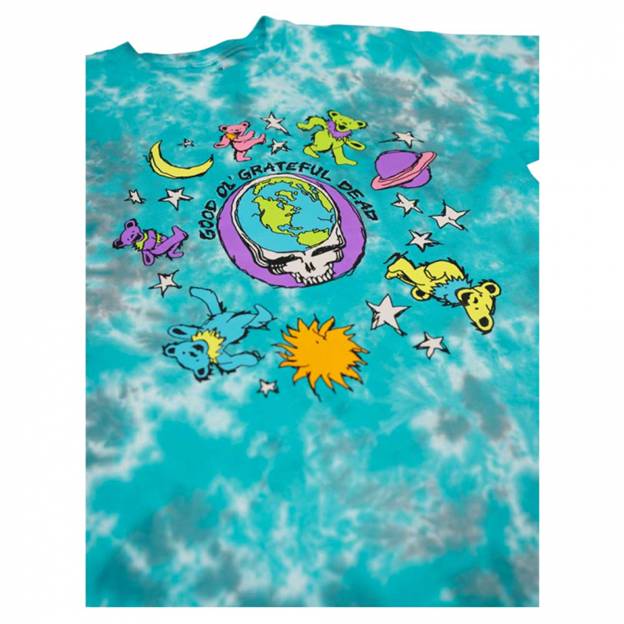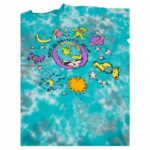The famous Dancing Bears from The Grateful Dead have permanently etched themselves into the band’s aesthetic. Since their debut on the remastered 1973 album’s cover, The Legacy of Grateful Dead, Volume 1, the outlook about band merchandise is that it has been treated as reprinted on counterfeit goods including t-shirts, posters, and even headbands.
Bear Stanley, not only introduced the dancing bear logo to the band but also had a great deal to do with the LSD being printed with the same picture by the band’s following. The dancing bear emblem was initially applied as stickers on Bear’s amps and other audio equipment.
The Grateful Dead is once again at the top of the cultural zeitgeist. This suggests that the peculiar brand extension of the Dead will persist, and not only on your adolescent daughter’s grateful dead clothing, like her Stealie shirt and hoodie, to be heard and seen in unexpected places.
Steal Your Face As An Everlasting Emblem
For everyone else, it is the Steal Your Face; for the uninitiated, it is just the weird tattoos and the red and blue visage shown on signs. In the late 1960’s, that lightning and skull emblem became known as the artwork for the Steal Your Face album, and known simply as “Stealie”.
The song “He is Gone” is about Mickey Hart Sr., the band’s former manager, and because of his theft from the band, Stealie’s name comes from a line in the song. Although many of the bands following aren’t aware of the story behind the logo involving the theft and simply associated the logo with drugs because of the known LSD use by the band and their following.
The possibility of achieving a state of heightened consciousness and enlightenment by pharmacological inducement or more conventional methods is hinted at by the lightning bolt shattering the skull. Naturally, the majority of people automatically believe this has something connected with the suspected LSD trips Deadheads were rumored to be experiencing at the gigs, and it is probably why the band allowed fans to think this was an accurate story of the logo.
The Dance-Loving Bears
Whether they are high-stepping or dancing, the jovial bears serve as the Grateful Dead’s logo. To learn more about mascots, go here. More than 50 years after Bob Thomas’ first illustrations of them, they are still the brand’s cheery ambassadors.
Following the release of the record, dancing bears could be seen in Owsley Stanley’s blotter art, which was common during Grateful Dead performances. Because the Grateful Dead had just released a live album with the bears on the cover, people were getting high on Owsley’s dancing cubs paper LSD while seeing them perform. It is not difficult to comprehend why the band, their sound, their enthusiasm, and even LSD have all come to be associated with the sign.
Although there are plenty of unlicensed reproductions of these logos, the band always looked at this as free advertisement for their music and merchandise. It wasn’t really frowned upon, and you’ll still find plenty of unlicensed versions of their logos on items for sale even to this day at various venues. This pattern remained for over 20 years following the time the bear was initially introduced.

It is incredible to see how the Grateful Dead impacted modern United States popular culture, not solely via their music but also through works of art that included their distinctive tie-dye look. Click here for more on tie-dye methods and styles. Despite the fact that it has been close to 25 years following the band’s final concert, the culture has not diminished.
There are plenty of well-known band logos around the world, but none have been so iconic as the Dead. For example, Guns’ N Roses remained popular from the late eighties until the early 2000’s, and they have one of the most recognizable bands emblems out there, and still aren’t as easily recognizable. The fact that they haven’t had their logo printed on blotter acid might have something to do with that, but the subject hasn’t been broached in that fashion.
Since then, it has appeared on merchandising, album covers, and a variety of fan art. Even in death, they band members continue to be heralded as advertising geniuses simply for the way the logos have stood the test of time. He would continue to create unique memorial artwork for the organization up until his death in 1991.
Skulls & Roses
Even yet, Stanley “Mouse” Miller, who created the band Grateful Dead’s self-entitled 1971 live album’s record cover after being moved by a book of poetry he found in a San Francisco library, would likely be surprised to hear that you can buy a Skull & Roses face towel online from Amazon. If you’re up for it, you can even purchase dancing bears teaspoon sets.


